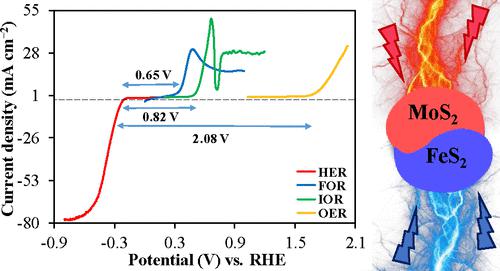当前位置:
X-MOL 学术
›
ACS Appl. Energy Mater.
›
论文详情
Our official English website, www.x-mol.net, welcomes your
feedback! (Note: you will need to create a separate account there.)
Introduction of MoS2–FeS2 with an S-Vacancy Defect as an Efficient Bifunctional Electrocatalyst for Hydrogen Evolution Reaction and Ferrocyanide and Iodide Oxidation Reactions
ACS Applied Energy Materials ( IF 5.4 ) Pub Date : 2024-03-15 , DOI: 10.1021/acsaem.3c02956
Hossein Ashrafi 1 , Morteza Akhond 1 , Behzad Haghighi 1
ACS Applied Energy Materials ( IF 5.4 ) Pub Date : 2024-03-15 , DOI: 10.1021/acsaem.3c02956
Hossein Ashrafi 1 , Morteza Akhond 1 , Behzad Haghighi 1
Affiliation

|
A composite of MoS2–FeS2 was synthesized and applied as a bifunctional electrocatalyst to fabricate a modified glassy carbon electrode capable of facilitating the hydrogen evolution reaction (HER), iodide oxidation reaction (IOR), and ferrocyanide oxidation reaction (FOR). The investigation delved into the influence of chemical composition and experimental variables on the electrocatalytic performance of MoS2–FeS2 toward HER. The observed electrocatalytic metrics, including Tafel slope, onset potential, turnover frequency, and stability toward HER, demonstrated comparability with those achieved using Pt/C. This comparison underscores the potential of MoS2–FeS2 as an attractive alternative to Pt/C for electrocatalytic applications, offering similar performance while potentially addressing cost and environmental concerns linked to platinum-based catalysts. Furthermore, the versatility of the MoS2–FeS2 composite was evident in its catalytic activity not only for HER but also for IOR and FOR, indicating its suitability across various electrochemical processes. Subsequent exploration focused on the electrocatalytic behavior of MoS2–FeS2 in the iodide oxidation reaction (IOR) and ferrocyanide oxidation reaction (FOR), which could potentially replace the oxygen evolution reaction (OER). The findings highlighted MoS2–FeS2’s significantly superior electrocatalytic performance compared to RuO2 in these reactions. Additionally, the required potentials for HER at the cathode and IOR at the anode in a HER-IOR configuration, as well as HER at the cathode and FOR at the anode in a HER-FOR setup, were notably lower, measured at 0.82 and 0.65 V, respectively, than those obtained in a HER-OER setup (2.08 V) using the MoS2–FeS2 modified electrode under similar experimental conditions. This exceptional electrocatalytic performance of MoS2–FeS2 was attributed to enhanced conductivity, a substantial electroactive surface area with numerous active sites, synergistic interactions between FeS2 and MoS2 sites, a high density of shared and bridging disulfide sites, a prevalence of sulfur vacancies within MoS2–FeS2, and minimal structural degradation.
中文翻译:

引入具有 S 空位缺陷的 MoS2-FeS2 作为析氢反应以及亚铁氰化物和碘化物氧化反应的高效双功能电催化剂
合成了MoS 2 -FeS 2复合材料,并将其用作双功能电催化剂,制备了能够促进析氢反应(HER)、碘化物氧化反应(IOR)和亚铁氰化物氧化反应(FOR)的改性玻碳电极。该研究深入探讨了化学成分和实验变量对MoS 2 –FeS 2 HER电催化性能的影响。观察到的电催化指标,包括塔菲尔斜率、起始电位、周转频率和 HER 稳定性,证明了与使用 Pt/C 获得的结果具有可比性。这一比较强调了 MoS 2 –FeS 2作为电催化应用中 Pt/C 有吸引力的替代品的潜力,提供相似的性能,同时可能解决与铂基催化剂相关的成本和环境问题。此外,MoS 2 -FeS 2复合材料的多功能性在其催化活性方面是显而易见的,不仅对HER,而且对IOR和FOR,表明其适用于各种电化学过程。随后的探索集中在MoS 2 -FeS 2在碘化物氧化反应(IOR)和亚铁氰化物氧化反应(FOR)中的电催化行为,这有可能取代析氧反应(OER)。研究结果强调了 MoS 2 –FeS 2在这些反应中与 RuO 2相比具有显着优越的电催化性能。此外,在 HER-IOR 配置中,阴极处的 HER 和阳极处的 IOR 所需的电势,以及 HER-FOR 设置中阴极处的 HER 和阳极处的 FOR 所需的电势明显较低,测得的电势分别为 0.82 和 0.65 V 分别高于在类似实验条件下使用 MoS 2 –FeS 2修饰电极在 HER-OER 设置 (2.08 V) 中获得的结果。 MoS 2 –FeS 2的这种出色的电催化性能归因于增强的电导率、具有众多活性位点的大量电活性表面积、FeS 2和 MoS 2位点之间的协同相互作用、高密度的共享和桥接二硫化物位点、硫的普遍存在MoS 2 –FeS 2内的空位,以及最小的结构退化。
更新日期:2024-03-15
中文翻译:

引入具有 S 空位缺陷的 MoS2-FeS2 作为析氢反应以及亚铁氰化物和碘化物氧化反应的高效双功能电催化剂
合成了MoS 2 -FeS 2复合材料,并将其用作双功能电催化剂,制备了能够促进析氢反应(HER)、碘化物氧化反应(IOR)和亚铁氰化物氧化反应(FOR)的改性玻碳电极。该研究深入探讨了化学成分和实验变量对MoS 2 –FeS 2 HER电催化性能的影响。观察到的电催化指标,包括塔菲尔斜率、起始电位、周转频率和 HER 稳定性,证明了与使用 Pt/C 获得的结果具有可比性。这一比较强调了 MoS 2 –FeS 2作为电催化应用中 Pt/C 有吸引力的替代品的潜力,提供相似的性能,同时可能解决与铂基催化剂相关的成本和环境问题。此外,MoS 2 -FeS 2复合材料的多功能性在其催化活性方面是显而易见的,不仅对HER,而且对IOR和FOR,表明其适用于各种电化学过程。随后的探索集中在MoS 2 -FeS 2在碘化物氧化反应(IOR)和亚铁氰化物氧化反应(FOR)中的电催化行为,这有可能取代析氧反应(OER)。研究结果强调了 MoS 2 –FeS 2在这些反应中与 RuO 2相比具有显着优越的电催化性能。此外,在 HER-IOR 配置中,阴极处的 HER 和阳极处的 IOR 所需的电势,以及 HER-FOR 设置中阴极处的 HER 和阳极处的 FOR 所需的电势明显较低,测得的电势分别为 0.82 和 0.65 V 分别高于在类似实验条件下使用 MoS 2 –FeS 2修饰电极在 HER-OER 设置 (2.08 V) 中获得的结果。 MoS 2 –FeS 2的这种出色的电催化性能归因于增强的电导率、具有众多活性位点的大量电活性表面积、FeS 2和 MoS 2位点之间的协同相互作用、高密度的共享和桥接二硫化物位点、硫的普遍存在MoS 2 –FeS 2内的空位,以及最小的结构退化。

































 京公网安备 11010802027423号
京公网安备 11010802027423号